#reedfish
Explore tagged Tumblr posts
Text
Taxonomy Tournament: Fish
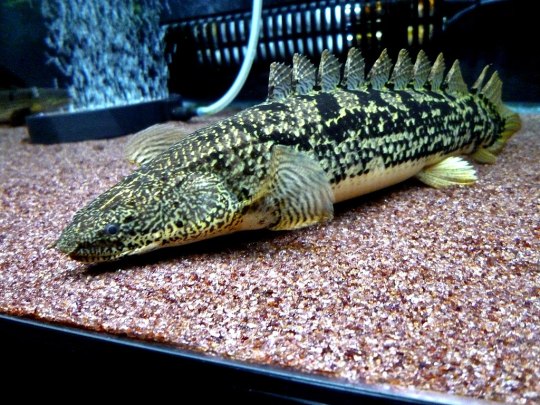
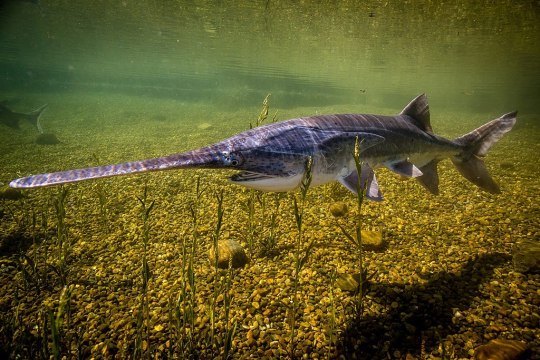
Polypteridae. This order is made up of reedfish and bichirs, freshwater fish that have lungs, with some species capable of breathing air.
Acipenseriformes. This order is made up of basal fishes with skeletons made mostly of cartilage. It includes sturgeons and paddlefish.
#animals#biology#polls#poll tournament#zoology#reedfish#bichirs#fish#sturgeons#Polypteridae#Acipenseriformes#0x4v0x3b
439 notes
·
View notes
Text
Noodles! ( in various shapes and sizes)
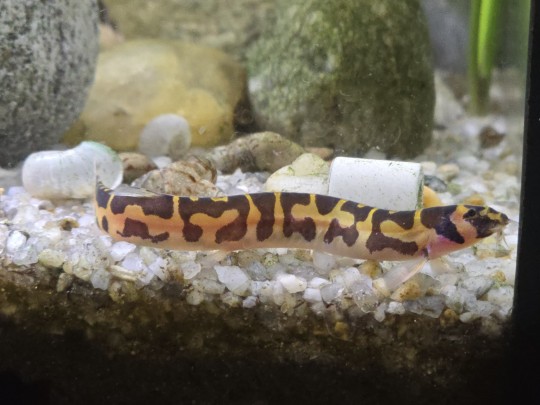
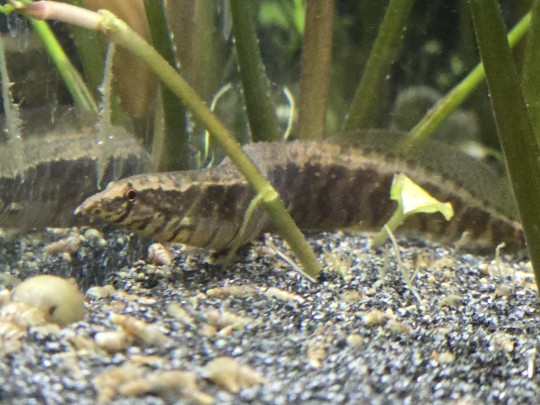
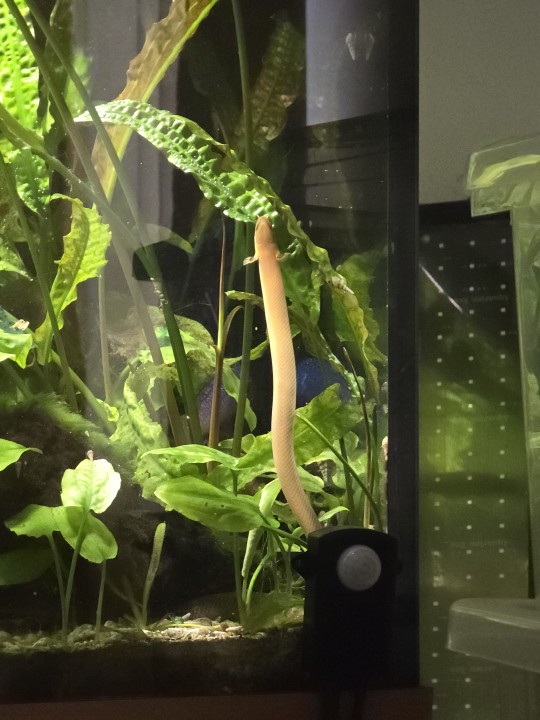
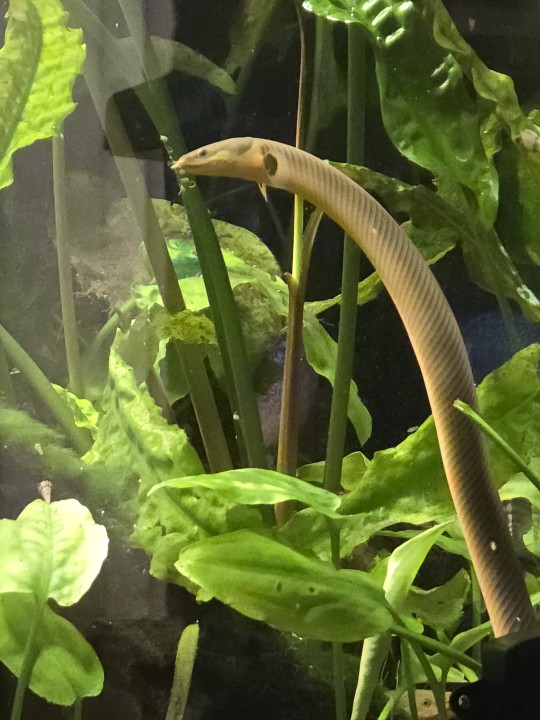
128 notes
·
View notes
Text
Support Saturday: Reedfish

Image Credit: Unknown
There are two main ways you can show support for the Reedfish(Erpetoichthys calabaricus). The first is to learn about the palm oil industry and how it is bad for the environment, and then avoid purchasing products with palm oil from unsustainable sources. One of the easiest ways to do that is to download the Palm Oil Scan app. This app is funded by the World Association of Zoos and Aquariums(WAZA) and allows you to scan bar codes on products to see if the product is sustainable.
The second way you can support Reedfish is to avoid purchasing them as pets. I know, they are cute, but it's generally harmful to keep wild-caught animals, unless you are someone who is trying to figure out how to successfully breed and raise them in captivity. If you own a wild-caught Reedfish, don't try and get rid of it, just keep it and try not to get any more.
There are also stickers you can get of the Reedfish! Here are some links to ones I could find.
Ropefish By MapleSquidArts
Ropefish By Dorian NOEL
Ropefish By DangCuteFish
#animaloftheweek#supportsaturday#support artists#wildlife#zoology#animals#aotw#animal facts#conservation#cool animals#weird animals#support the environment#ecology#fish#fishblr#reedfish#ropefish
14 notes
·
View notes
Text
Daily fish fact #561
Reedfish!
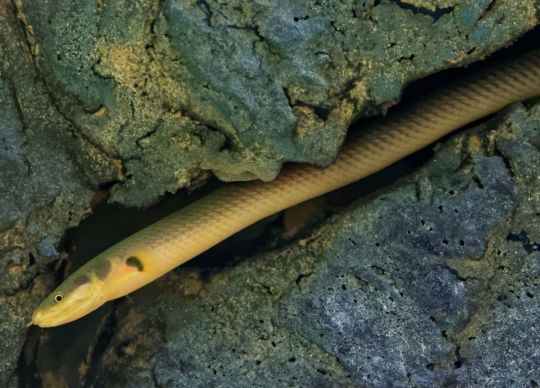
Their larvae have external gills, making them resemble salamander larvae. Due to their elongated bodies, their movements are very snakelike as they swim close to the bottom of their habitat.
131 notes
·
View notes
Text

I made a Zelda OC/sona :]
#legend of zelda#zelda fanart#zelda oc#zora#reedfish oc#fi skyward sword#loz#loz fanart#loz botw#loz totk#loz tp#they’re based on a Reedfish specifically#I love Reedfish they’re silly little guys#very :3#also I’m gonna draw selfship of xem and Fi you’ve been warned
40 notes
·
View notes
Text
Round 2 - Chordata - Actinopterygii
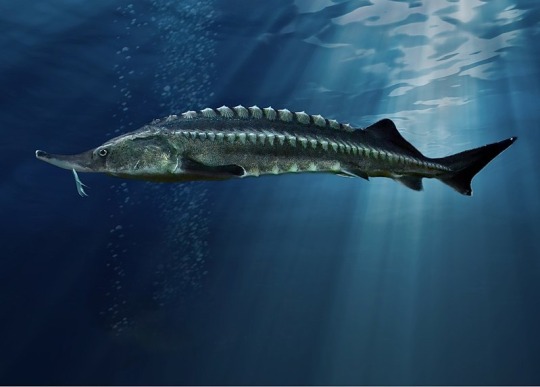
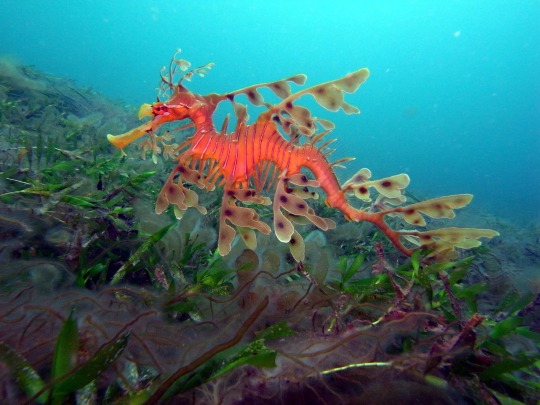

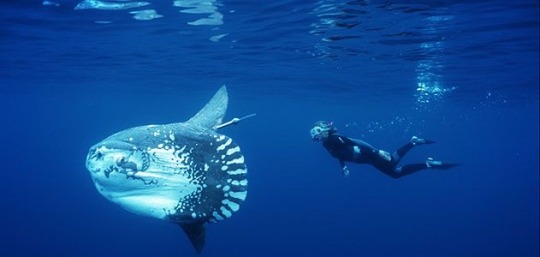
(Sources - 1, 2, 3, 4)
Over 50% of chordate species are Actinopterygians (“Ray-finned Fishes”). There are over 30,000 species, comprised of the Polypteriformes (“Bichirs” and “Reedfish”), Acipenseriformes (“Sturgeons” and “Paddlefish”), Amiiformes (“Bowfins”), Lepisosteiformes (“Gar”), and the Teleosts (about 40 orders containing all rest of the actinopterygians).
Ray-finned Fishes are so called because of their lightly built fins made of skin webbings supported by thin bony spines. Actinopterygians are unique for their swim bladder, an organ that allows them to adjust their buoyancy. They are the most abundant free-swimming aquatic animals and can be found almost anywhere there is water. They come in a vast majority of sizes, shapes, scale-types, fin-arrangements, colors, and behaviors, from the 8 mm (0.3 in) long Paedocypris to the 11 m (36 ft) long Giant Oarfish (Regalecus glesne) to the 2,744 kg (6,049 lb) Giant Sunfish (Mola alexandrini). They have feeding strategies ranging from predatory to grazing to filter-feeding.
In most actinopterygians, males and females exist and reproduce through external fertilization. However, some species utilize sequential hermaphroditism, in which they start life as females and convert to males at some point. In a few species, they start life as males and convert to females. Some species give live birth, and some species self-fertilise. Some abandon their young, while some practice maternal and/or even paternal care.
The earliest known actinopterygian is Andreolepis hedei, from the Late Silurian. The teleosts in particular diversified wildly during the Mesozoic, resulting in the high diversity of shapes we see today. The earliest fossil relatives of modern teleosts, (Prohalecites and Pholidophorus), are from the Triassic period, though it is suspected that teleosts originated already during the Paleozoic Era.
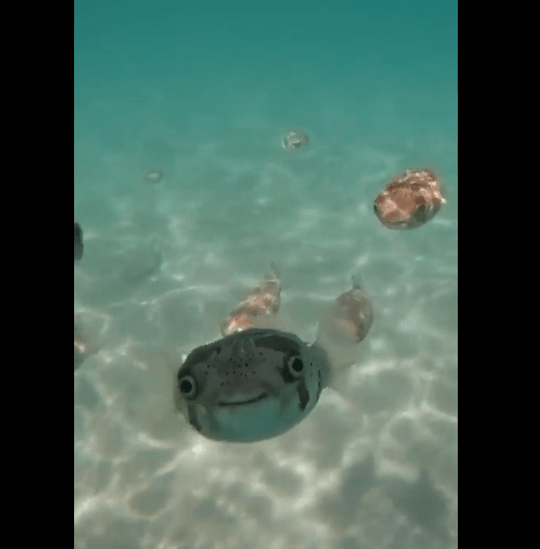
Propaganda under the cut:
Many Actinopterygians, especially those that live in the deep sea, are bioluminescent, glowing in a variety of colors and patterns to attract prey, mates, or even just communicate.
Some species of Puffer Fish (Family Tetrapdontidae) are highly poisonous, second only among vertebrates to the Golden Dart Frog (Phyllobates terribilis).
The most venomous fish is the Reef Stonefish (Synanceia verrucosa). The spines on its back produce a venom which can cause severe pain, shock, paralysis, and tissue death in humans.
Male Seahorses (Genus Hippocampus) are known for having a pouch in which they carry eggs laid by the female.
The Harlequin Tuskfish (Choerodon fasciatus) has electric blue vampire teeth.
Speaking of teeth, Serrasalmids have jaws ranging from human-looking nutcracker teeth to bear-trap looking flesh-eating chompers.
The Mandarinfish (Synchiropus splendidus) and the Picturesque Dragonet (Synchiropus picturatus) are the only two vertebrate species known to produce their own true blue coloring. Blue as a color is usually a result of reflected light, and almost all cells that are perceived as blue are actually a reflective black. However, these two mandarinfish species have cyanophores, which are both blue in pigment and reflective, making them the most blue animals in nature.
Many fish are popular in the pet trade (some more ethical pets than others) and some have even been domesticated and bred to display a variety of colors and shapes, including goldfish, koi, Betta, and zebrafish.
Moray Eels (family Muraenidae) have a hidden set of internal jaws, called pharyngeal jaws. While most predatory fish use suction to “inhale” their prey, moray eels just… pull them in.
The Mangrove Rivulus (Kryptolebias marmoratus), a species of killifish, mostly breeds by self-fertilization and can survive for about two months on land. Males are rare, and can only hatch from eggs kept below 19 °C (66 °F).
The most famous pupfish (family Cyprinodontidae, also a type of killifish) is probably the Devils Hole Pupfish (Cyprinodon diabolis). It is a critically endangered species found only in Devil’s Hole, a water-filled cavern in the US state of Nevada. When nearby agricultural irrigation caused the water to drop in the cavern, several court cases ensued, resulting in Devils Hole being declared a National Monument in 1952, including the preservation of adequate groundwater to maintain the pool. As of September 2022, the count showed a total of 263 observed wild pupfish, up from only 35 in 2013.
There are waaaay too many cool fish for me to write about; I keep thinking of cool facts but this is already getting so long and I gotta save some for if this class makes it to the next round 🥲
103 notes
·
View notes
Text

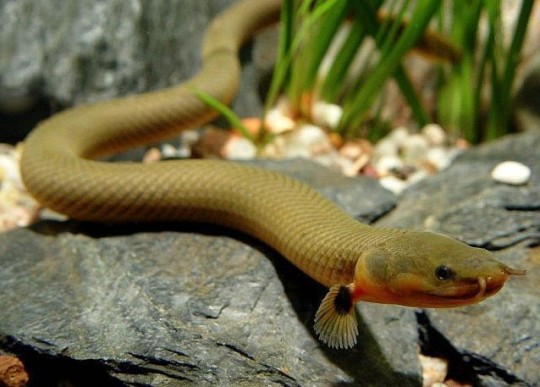
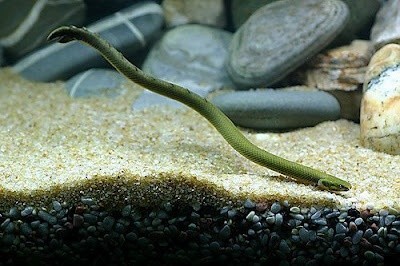

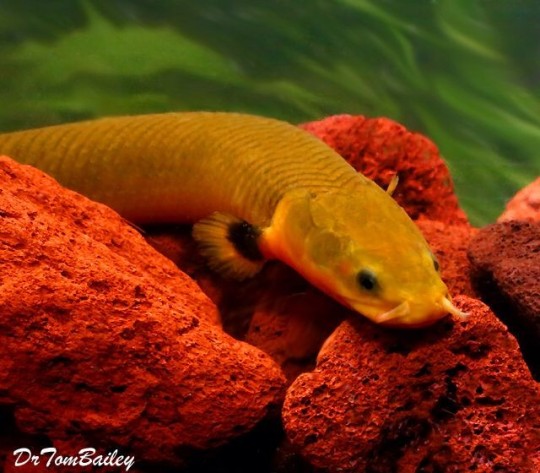
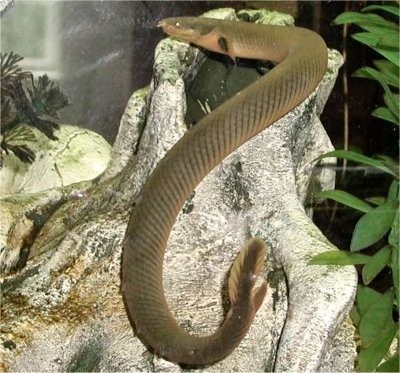

The reedfish, ropefish (more commonly used in the United States), or snakefish, Erpetoichthys calabaricus, is a species of fish in the family Polypteridae alongside the bichirs. It is the only member of the genus Erpetoichthys. It is native to fresh and brackish waters in West and Central Africa. The reedfish possesses a pair of lungs in addition to gills, allowing it to survive in very oxygen-poor water. It is threatened by habitat loss through palm oil plantations, other agriculture, deforestation, and urban development.
The largest confirmed reedfish museum specimen was 37 cm (15 in) long, and three studies where more than 2,000 wild reedfish were caught (using basket traps, meaning that only individuals longer than 15–20 cm [6–8 in] were retained) found none that exceeded 41.4 cm (16.3 in). Although sometimes claimed to reach up to 90 cm (3 ft) long, this is incorrect.
Body elongation in fishes, such as eels, usually happens through the addition of caudal (tail) vertebrae, but in bichirs it has happened through the addition of precaudal vertebrae. Reedfish have evolved a more snakelike body by having twice as many precaudal vertebrae as the members of its sister genus Polypterus, despite having the same number of tail vertebrae. Pelvic fins are absent, and the long dorsal fin consist of a series of well-separated spines, each supporting one or several articulated rays and a membrane. The reedfish possesses a pair of lungs, enabling it to breathe atmospheric air. This allows the species to survive in water with low dissolved oxygen content and to survive for an intermediate amount of time out of water. The sexes are very similar in both median and maximum length, but females average heavier than males of a similar length, and they can be reliably separated by the shape of their anal fin. Reedfish are dark above and on the sides, with lighter orangish or yellowish underparts. Males are generally more olive-green in colour, whereas females generally are more yellowish-brown. Larvae have conspicuous external gills, making them resemble salamander larvae.
The genus name derives from the Greek words erpeton (creeping thing) and ichthys (fish).
11 notes
·
View notes
Text
ohmygod these pics r so bad.
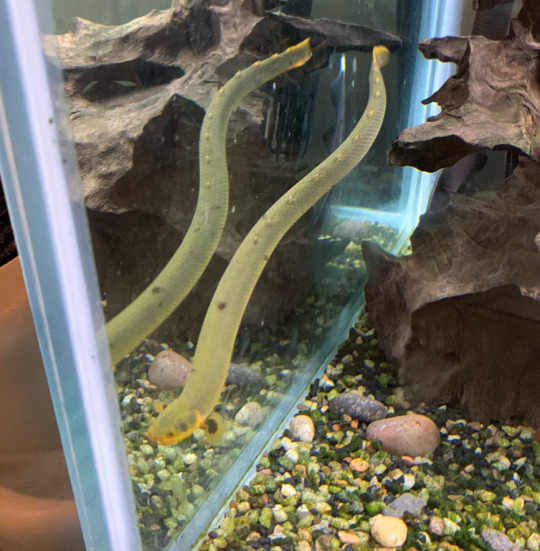

i dont know what this isbut i was absolutely mesmerized by it while i was talking to this guy. it looks like a mini dragon..

I HAVE TO SHOW U GUYS THIE FREAKY ASS FISH I SAW AT A RESTAURANT TODAY
#picjures#crab post#anyone knw what this is...#i thought golden loach but its kinda different#kinda cute#there was also a black ghost knifefish but we wanted to get going#I FOUND IT!! it is a reedfish#google search: 'aquarium fish looks like snake' and they knew EXACTLY what i meant
61 notes
·
View notes
Text
Okay my childhood hyperfixation on aquariums has returned with a VENGEANCE, so I want to make a post of all my dream fish
Norman’s lampeye:

Pea puffer:


Kuhli loach:


Chocolate gourami:

Reedfish:


9 notes
·
View notes
Text


Ampullae of Lorenzini (singular Ampulla) are electroreceptors, sense organs able to detect electric fields. They form a network of mucus-filled pores in the skin of cartilaginous fish (sharks, rays, and chimaeras) and of basal bony fishes such as reedfish, sturgeon, and lungfish. They are associated with and evolved from the mechanosensory lateral line organs of early vertebrates. Most bony fishes and terrestrial vertebrates have lost their ampullae of Lorenzini.
A positive pore stimulus decreases the rate of nerve activity coming from the electroreceptor cells, while a negative pore stimulus increases the rate. Each ampulla contains a single layer of receptor cells, separated by supporting cells. The cells are connected by apical tight junctions so that no current leaks between them. The apical faces of the receptor cells have a small surface area with a high concentration of voltage-dependent calcium channels (which trigger depolarisation) and calcium-activated potassium channels (for repolarisation afterwards).
Because the canal wall has a very high resistance, all the voltage difference between the pore of the canal and the ampulla is dropped across the 50 micron-thick receptor epithelium. Because the basal membranes of the receptor cells have a lower resistance, most of the voltage is dropped across the excitable apical faces which are poised at the threshold. Inward calcium current across the receptor cells depolarises the basal faces, causing a large action potential, a wave of depolarisation followed by repolarisation (as in a nerve fibre). This triggers presynaptic calcium release and release of excitatory transmitter onto the afferent nerve fibres. These fibres signal the size of the detected electric field to the fish's brain.
The ampulla contains large conductance calcium-activated potassium channels (BK channels). Sharks are much more sensitive to electric fields than electroreceptive freshwater fish, and indeed than any other animal, with a threshold of sensitivity as low as 5 nV/cm. The collagen jelly, a hydrogel, that fills the ampullae canals has one of the highest proton conductivity capabilities of any biological material. It contains keratan sulfate in 97% water, and has a conductivity of about 1.8 mS/cm. All animals produce an electrical field caused by muscle contractions; electroreceptive fish may pick up weak electrical stimuli from the muscle contractions of their prey.
3 notes
·
View notes
Text
Taxonomy Tournament: Fish


Salmoniformes. This order is made up of migratory carnivorous fish, including salmon and trout.
Polypteridae. This order is made up of reedfish and bichirs, freshwater fish that have lungs, with some species capable of breathing air.
#animals#biology#polls#poll tournament#zoology#salmon#trout#fish#reedfish#bichirs#Salmoniformes#Polypteridae#0x7bv0x84#animal tournament#Animal Tournament Round 1
194 notes
·
View notes
Text
Here's a video of something I find endlessly interesting.
How my single jewel chichlid and my group of leopard bushfisch interact.
The fact that they can understand each other; they have similar body language. They bump into each other, show some dominance display, but never bite each other or fight.
Both are very intelligent fish species. You can see how the bushfish inspect the mop i put in today (very cautious, keeping distance, giving it the sideeye) versus the chichlid (trying to take a bite out of it). So the bushfish sometimes follow the chichlids lead. (If it didn't harm him, it's probably OK)
Also everyone in this tank is apparently smart enough not to bite; and to realize that the other fish in the tank won't take a bite out of them either. I'm pretty sure in nature no fish would stay calm if a bichir frontal bumps into their side, but the bushfisch dgaf.
It is, all in all, probably the most peaceful tank i have (except the shrimptanks), even though it has the biggest fish.
The guppy tank looks more violent than this one.
#aquarium#fishblr#bichir#freshwater aquarium#fish#aquablr#my 450l tank#fishtank#ropefish#reedfish#leopard bushfish#jewel chichlid#planted aquarium#planted tank
42 notes
·
View notes
Text
Animal of the Week: Reedfish

Image Credit: Michal Zalewski
Meet the animal Monday! This week, we have another long, snake-like creature called the Reedfish(Erpetoichthys calabaricus)! It's also commonly known as the Ropefish or Snakefish! These happy little fish are native to areas around Benin, Cameroon, and Nigeria.
#meetanimalmonday#animaloftheweek#cool animals#animal facts#weird animals#animal of the week#wildlife#zoology#animals#conservation#fish#aotw#reedfish#ropefish#fishblr#fresh water
15 notes
·
View notes
Note
Using phylogeny to horribly warp the definition of a fish, my favourite fish is probably the binturong (Although all procyonids are also incredible). There's just something great about a mid-sized feliform with a semi-prehensile tail and a smell of popcorn about it. Plus they sometimes look like haggard old men and it's fantastic. Using fish to mean things people classically refer to as fish, I love polypterids (Bichir) etc. I love the fact some of them can move around on land, I love how basal they are to all the other ray finned fish (Nothing against other ray finned fish, there's just something charming about lonely branches on the tree of life to me), I love their shapes, I love the fact reedfish/ropefish look like they're smiling. I love the fact they (and everyone walking past) will side eye me if I baby talk them at my nearest aquarist. A tier fish, one day I will live in a place large enough to have one.
Fine tetrapod and true fish choices! Bichirs are cool fish indeed, I don’t think I appreciate them enough for just how cool they are; they even have lungs!! I’ll need to research them a bit more, it’s clear, and spread bichir joy in the world.

Binturong joy, too. Unappreciated animals deserve recognition! Plus they literally look like this:

If the Muskrat from the Moomins wasn’t already a, you know, muskrat…. He should’ve been this. 100%. Perfect nihilistic philosopher.
24 notes
·
View notes
Text
not really normal fish but do bichir count as long enough? (otherwise there's their secret longer cousin the reedfish)
im a big fan of long fish. sturgeon, arapaima, gar. just normal fish that have been stretched out
#they're like half lungfish half ray finned fish i love them#technically slightly closer to normal ray-finned fish but retained some extremely primitive traits#so they kept stuff like lungs and fleshy front fins which more derived fish lost#yes fish used to have lungs before#that's where the swim bladder evolved from btw
5K notes
·
View notes
Video
youtube
AWESOME ROPE FISH / SNAKEFISH / REEDFISH ( Erpetoichthys calabaricus) HD
#youtube#Fish#Exotic Fish#Rope Fish#Snakefish#Reed Fish#Freshwater fish#Carnivore#Looks Like Eel#Elongated Body#Swims Like Snake#Lokaranjan Aqua World#Underwater Zone Mysore
0 notes